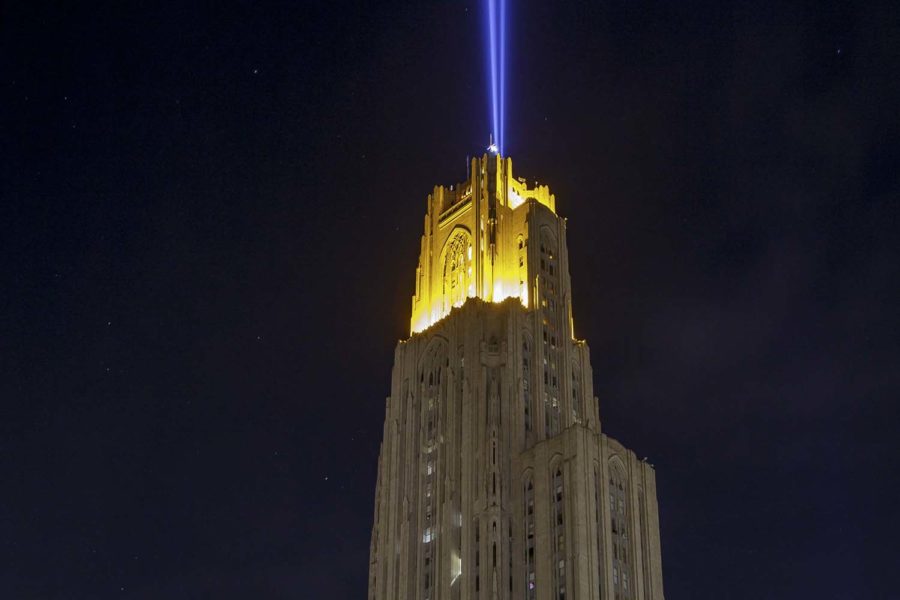Birding Club to collect data on bird deaths from victory lights
Thomas Yang | Assistant Visual Editor
The blue beam was added to the Cathedral of Learning’s Victory Lights in 2018.
October 10, 2019
The Victory Lights that shine up from the Cathedral of Learning may be a point of pride for Pitt students, but some Pitt community members worry that they’re also a potentially dangerous attraction for migrating birds.
Concern about the lights’ effect on birds was first brought to the University’s attention in September 2018 when former Pitt faculty member and Audubon Society of Western Pennsylvania board member Tony Bledsoe read a blog post by local bird enthusiast Kate St. John detailing the issue.
“City lights are a fatal attraction for songbirds because they migrate at night using celestial lights for navigation,” St. John wrote in her article. “Lured by artificial lights, they become confused and circle them.”
This circling sometimes exhausts them, causing them to collide with the light source or building. Nearly half a billion birds die each year due to such collisions. Pitt believes it has since found a way to mitigate the lights’ risk to birds, and the Pitt Birding and Ornithology Club intends to determine if the University’s solution is working.
In her blog post, St. John compared the Victory Lights to an annual 9/11-tribute light show in New York, where bird enthusiasts have been able to successfully prevent bird deaths. At this event each year, volunteers lay on the ground and stare up at the lights, and once they count 1,000 birds, or find a single dead bird, the tribute lights are shut off for 20 minutes. This gives the birds time to reorient themselves and continue migrating rather than exhaust themselves by continuously circling the lights.
After reading St. John’s post, Bledsoe contacted Jim Bonner, the executive director at ASWP, to see if the solution that worked in New York could potentially work in Oakland. Bonner was able to coordinate a meeting with Chancellor Patrick Gallagher the same day, where they discussed their ideas.
“We got right to the top very quickly. The Chancellor directed various people from facilities to work with me,” said Bonner. “As a Pitt graduate, I couldn’t be more proud of the University’s response.”
That week, Bonner said Pitt’s facilities management team said they would not use the victory lights if the team won unless they were able to come up with a solution. In the process of deciding the best way to handle the victory lights, Bonner took St. John’s comparison into account, and reached out to his connections at the New York City Audubon to learn more about how they handled the 9/11-tribute lights.
“Because the 9/11-tribute lights are a one-time-a-year event and it’s an emotional-draw event, it’s pretty easy to mobilize volunteers who love birds to be there at the lights, and it makes the tribute important to them too,” St. John said. “The victory lights are not easy to predict and it’s hard to motivate volunteers at the last minute.”
Bonner and Pitt’s facilities management team worked out a plan. Instead of requiring a manual shutoff after volunteers count a certain number of birds, the Victory Lights’ cycle would be fully automated and the lights will shut off for 15 minutes out of every hour after a sports victory, regardless of the number of birds circling above.
Now, a year after the implementation of the alternating schedule, the Pitt Birding and Ornithology Club is beginning to monitor the birds flying by the Victory Lights and collect data to eventually draw conclusions about the new schedule’s ability to prevent bird deaths. Lauren Chronister, a junior ecology and evolution major and president of the Pitt Birding and Ornithology Club, already collected the first set of data on the Victory Lights after the Panthers beat the Delaware Blue Hens on Sept. 28.
“It was just me and one other member that night and we sat for approximately two and a half hours to watch two of the light cycles,” said Chronister. “Every five minutes I took a recording of how many birds I could see in the light and any other sort of observations such as big flocks passing through.”
Chronister said that it is still very early in the process and that they cannot conclude anything from the data they have so far. Additionally, they are still working out exactly how they are going to collect the data. They are considering the possibility of putting monitoring equipment on top of the Cathedral of Learning.
“I honestly think a camera up there would be useful, just to see what species of birds are getting stuck in the light more than others,” Chronister said.
While the collective effort to prevent unnecessary bird deaths from the Victory Lights is a victory for some birds migrating through Pittsburgh, the birds are still far from safe. According to St. John, the bright lights in downtown Pittsburgh are also a serious hazard.
“A study by Cornell said that there is really only 10 nights per season where migration is intense,” St. John said. “Cornell has the tools that you can tell if it’s going to be a good night for migration. If there was massive cooperation on the part of humans, they could darken the skies and it would really help.”
St. John and Chronister both said they believe protecting the migrating birds is important, since bird populations in North America are on a dramatic decline. According to a recent study by Cornell, bird populations in the United States and Canada have declined by nearly 30% during the past 50 years.
“I like birds. I like all animals and I think that we should be doing whatever we can to not mess up their environment,” said Chronister. “If we can mitigate our impacts, that would be excellent.”



